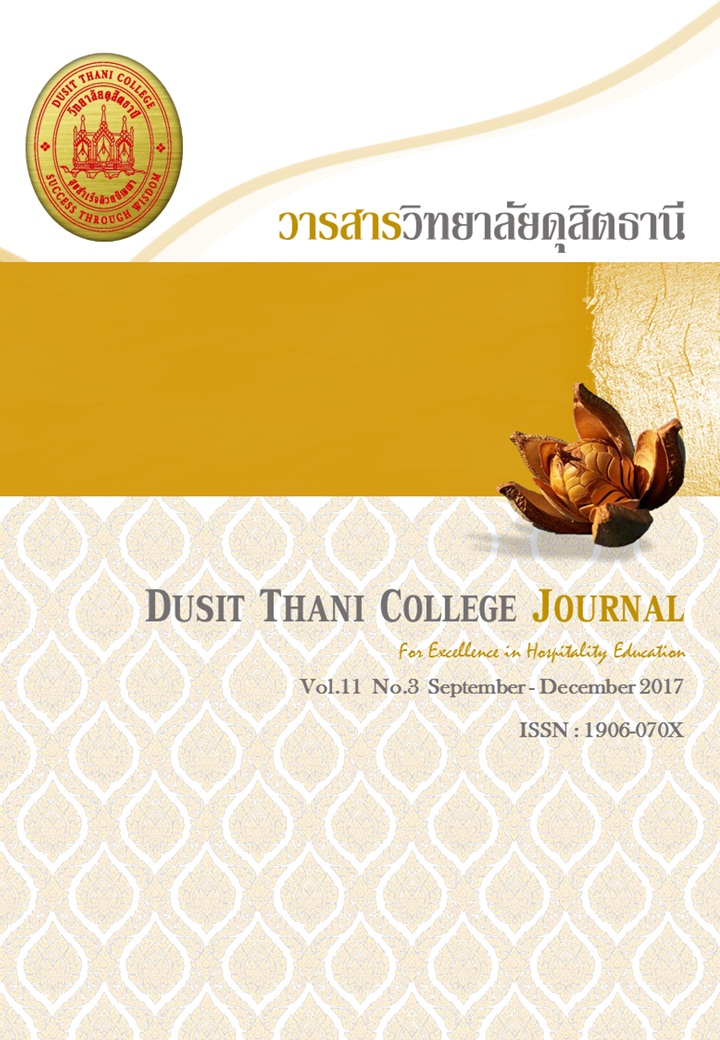มุมมองของนักท่องเที่ยวต่อผลกระทบทางสิ่งแวดล้อมในอุทยานแห่งชาติดอยอินทนนท์
Main Article Content
บทคัดย่อ
งานวิจัยเรื่องนี้วิเคราะห์ถึงความต่างของมุมมองนักท่องเที่ยวต่างเชื้อชาติต่อผลกระทบทางสิ่งแวดล้อมบนอุทยานแห่งชาติดอยอินทนนท์ เนื่องจากการท่องเที่ยวในอุทยานแห่งชาติมีอัตราที่เพิ่มขึ้นอย่างมากในหลายปีที่ผ่านมา จึงมีโอกาสที่จะส่งผลกระทบทางลบต่อพื้นที่ เนื่องด้วยพื้นที่คุ้มครองมีคุณค่าต่อทั้งด้านการศึกษา ด้านนันทนาการ และด้านนิเวศวิทยา การที่จะจัดการหรือแก้ปัญหาอย่างเหมาะสมนั้น ผลกระทบต่าง ๆ ต้องได้รับการศึกษาและทำความเข้าใจอย่างลึกซึ้ง เพื่อหาวิธีการจัดการได้อย่างตรงจุด งานวิจัยนี้จึงอธิบายถึงความเป็นไปได้ของผลกระทบที่มีโอกาสเกิดขึ้น รวมถึงคำแนะนำในการหลีกเลี่ยงผลกระทบและวิเคราะห์ให้ทราบถึงมุมมองต่อผลกระทบทางสิ่งแวดล้อมบนอุทยานแห่งชาติดอยอินทนนท์ของนักท่องเที่ยว 2 กลุ่ม คือ กลุ่มนักท่องเที่ยวจากประเทศฝั่งตะวันตกจำนวน 152 คน และประเทศฝั่งเอเชียจำนวน 248 คน รวมเป็น 400 คน โดยใช้การเก็บข้อมูลจากแบบสอบถาม ผลลัพธ์ที่ได้จากข้อมูลแสดงให้เห็นถึงความต่างของมุมมองในนักท่องเที่ยวทั้งสองกลุ่มต่อผลกระทบทางสิ่งแวดล้อมบนอุทยานแห่งชาติดอยอินทนนท์ พบว่า กลุ่มนักท่องเที่ยวจากประเทศฝั่งตะวันตกมีความตระหนักในเรื่องสิ่งแวดล้อม ปัญหา และผลกระทบที่เกิดขึ้น โดยมีความเชื่อว่าตนเองเป็นปัจจัยหลักในการสร้างผลกระทบของสิ่งแวดล้อมในด้านบวก ขณะที่นักท่องเที่ยวจากประเทศฝั่งเอเชียมีความกังวลเรื่องผลกระทบทางลบที่เกิดขึ้นในอุทยานจากตนเองเป็นหลัก
Article Details
นโยบายการพิจารณากลั่นกรองบทความ
- บทความวิจัยและบทความวิชาการทุกเรื่องที่จะได้รับการตีพิมพ์ต้องผ่านการพิจารณากลั่นกรองโดยผู้ทรงคุณวุฒิ (Peer Review) ในสาขาที่เกี่ยวข้อง จำนวน 3 ท่าน/บทความ
- บทความ ข้อความ ภาพประกอบและตารางประกอบที่ลงตีพิมพ์ในวารสารเป็นความคิดเห็นส่วนตัวของผู้เขียน กองบรรณาธิการไม่จำเป็นต้องเห็นด้วยเสมอไป และไม่มีส่วนรับผิดชอบใด ๆ ถือเป็นความรับผิดชอบของผู้เขียนแต่เพียงผู้เดียว
- บทความที่จะได้รับการตีพิมพ์จะต้องไม่เคยตีพิมพ์ เผยแพร่ที่ใดมาก่อน และไม่อยู่ระหว่างการพิจารณาของวารสารฉบับอื่น หากตรวจสอบพบว่ามีการตีพิมพ์ซ้ำซ้อน ถือเป็นความรับผิดชอบของผู้เขียนแต่เพียงผู้เดียว
- บทความใดที่ผู้อ่านเห็นว่าได้มีการลอกเลียนหรือแอบอ้างโดยปราศจากการอ้างอิง หรือทำให้เข้าใจผิดว่าเป็นผลงานของผู้เขียน กรุณาแจ้งให้กองบรรณาธิการวารสารทราบจะเป็นพระคุณยิ่ง
เอกสารอ้างอิง
Thailand. Retrieved October 11, 2017, from https://www.atta.or.th/?p=4019
Beltrán, J. (2000). Indigenous and traditional peoples and protected areas: Principles,
Guidelines and Case studies. Retrieved August 28, 2014, from
https://portals.iucn.org/library/efiles/edocs/PAG-004.pdf
Betz, H., Srisanga, P., & Suksathan, P. (2014). Doi Inthanon National Park, Chiang Mai,
Northern Thailand, Selected Plants of Doi Inthanon. Retrieved October 10, 2017,
from https://fieldguides.fieldmuseum.org/guides/guide/562
Boniface, B., & Cooper, C. (2011). Worldwide destination: The geography of travel and
tourism. (5thed.). London: Butterworth-Heinemann.
Buckley, R. (2003). Case studies in ecotourism. Oxon: CABI Publishing.
Ceballos-Lascuráin, H. (1996). Tourism, ecotourism and protected areas: the state of nature-based tourism around the world and guidelines for its development Gland: IUCN.
Cooper C., Fletcher J., Fyall A., Gilbert D., & Wanhill S. (2011). Tourism principles and
practice. (12thed.). Harlow: Pearson Education.
DINP. (2006). Visitor statistics 1998-June 2006. Chiang Mai: DINP.
DNWP. (2004). Statistical data: national park, wildlife and plant conservation. Bangkok: DNWP.
Eagles, P.F.J. & McCool, S.F. (2002). Tourism in national parks and protected areas:
planning and Management. Wallingford: CABI Publishing.
Eagles, P.F.J., McCool, S.F., & Haynes, C.D. (2003). Sustainable tourism in protected areas:
guidelines for planning and management. Gland: IUCN.
Holloway, C.J. (2009). The business of tourism. (5thed.). London: Prentice Hall.
Hunter, C. and Green, H. 1995. Tourism and the environment: a sustainable relationship?
London: Routledge.
Khaosa-ard, A., Khaosa-ard, M., Auprasit, A., Birala, A., Vijakprasert, P., Ruangjan, S., &
Rayanokorn, K. (1997). A summary for management: a management plan for the
Doi Inthanon National Park, second stage (1998-2007). Bangkok: The Thailand
Development Research Institute.
Khaosa-ard, A., Khao Sa-ard, M., Auprasit, A., Birala, A., Vijakprasert, P., Ruangjan, S., &
Rayanokorn, K. (1997). Knowledge assessment of the Doi Inthanon National Park.
Bangkok: The Thailand Development Research Institute.
Kiper, T. (2013). Role of Ecotourism in Sustainable Development. Environmental Sciences
“Advances in Landscape Architecture”. Online Access. Retrieved October 9, 2017,
from https://www.intechopen.com/books/advances-in-landscape-architecture/role-of-ecotourism-in-sustainable-development
Liburd, J.J., & Edwards, D. (2010). Understanding the Sustainable Development of Tourism.
Oxford: Goodfellow Publishers Limited.
Mason, P. (2011). Tourism impacts, planning and management. London: Routledge.
Mathieson, A. & Wall, G. (2012). Tourism: economic, physical, and social impacts.
(5thed.). London: Longman.
McNeely, J.A., Thorsell, J.W., & Ceballos-Lascuráin, H. (1992). Guidelines: development of
national parks and protected areas for tourism. Madrid: WTO.
Mieczkowski. Z. (1995). Environmental issues of tourism and recreation. London:
University Press of America.
Naturenet. (2017). Impacts of tourism on the environment. Retrieved October 10, 2017,
from https://www.naturenet.net/education/tourism.html
Newsome, D., Moore, S.A., & Dowling, R.K. (2002). Natural area tourism: ecology, impacts, and management. Clevedon: Channel View Publications.
Novelli, M. (2011). Niche Tourism: Contemporary Issues, trends and cases. New York: Routledge
Office of National Park. (2017). History of National Parks in Thailand. Retrieved October 10, 2017, from https://portal.dnp.go.th/Content/nationalpark?contentId=1169
Office of National Park. (2017). National Parks Tourist Statistics in Thailand. Retrieved October 10, 2017, from https://portal.dnp.go.th/Content/nationalpark?contentId=3719
Rungapadiachy, D., (1999). Interpersonal communication and psychology for health care prodessionals: Theory and Practice. London: Elsevier.
Samovar, L.A., & Porter, R.E., (1991). Intercultural communication: A reader. (6th ed.).
Belmont, CA: Wadsworth Publishing Company.
Shaw, G. & Williams, A.M. (2002). Critical issues in tourism: a geographical perspective.
Stefanica, M. & Butnaru, G.I. (2015). Research on Tourists’ Perception of the Relationship
between Tourism and Environment. Procedia Economics and Finance. Vol 20, (595-600).
Spenceley, A. (2008). Responsible Tourism. Critical Issues for Conservation and Development. London: Earthscan.
Thailand.com. (2004). National parks in Thailand [online]. Available from:
https://www.thailand.com/travel/natural/natural_nationalpark.htm
Accessed on: 27 March 2015
Tourism Authority of Thailand. (2017). Doi Inthanon National Park. Retrieved October 10, 2017, from https://www.tourismthailand.org/See-and-Do/Sights-and-Attractions-Detail/Doi-Inthanon-National-Park--153.
Thomas, L. & Middleton, J. (2003). Guidelines for management planning of protected areas. Gland; Cambridge: IUCN.
TIES. (2000). Ecotourism statistical fact sheet. Retrieved September 12, 2014, from
https://www.ecotourism.org/research/stats/files/stats.pdf.
TIES. (2003). What is ecotourism [online]? Washington, DC: TIES Retrieved September 12,
2014, from https://www.ecotourism.org/index2.php?what-is-ecotourism
UNWTO. (2016). UNWTO Tourism Highlights, 2016 Edition. Retrieved October 9, 2017, from
https://mkt.unwto.org/en/barometer.
Wearing, S. & Neil, J. (2011). Ecotourism: impacts, potentials, and possibilities. (5thed.).
Oxford: Butterworth-Heinemann.
Weaver, D. & Lawton, L. (2014). Tourism Management. (5thed.). London: Wiley.
WTO. (2017). Historical perspective of world tourism. Retrieved October 9, 2017,
from https://www.world-tourism.org/


